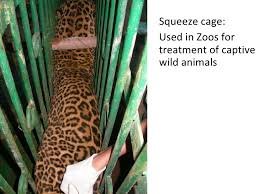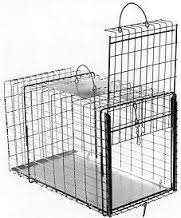PHYSICAL RESTRAINING OF WILD ANIMALS
Dr. Avantika Sharma
PhD scholar
Department of Veterinary Pathology
Guru Angad Dev Veterinary and Animal Sciences University, Ludhiana, Punjab, India.
Email: avantikavet123@gmail.com
INTRODUCTION-
Restraint is measure or condition that keeps someone or something under control. The wild animals are often required to catch and restraint for various kind of routine operations like detailed examination, treatment, shifting and crating of animal. Knowledge of the different methods of restraint is important for successful wildlife management.
There are various kinds of equipment’s and techniques used for capturing and restraining of wild animals. One of the important techniques includes Physical restraint.
It is very much essential to evaluate the physical condition of the animals and the justification of capture because each restraint has some effect on behaviour, on the life or physiological activities of animal. Some of the animals like black buck, chinkara and deer’s etc are very much sensitive to restraint and susceptible to shock, even a simple capturing may result in injury or death to animal.
PLANNING–
Most state wildlife agencies offer in-house courses regarding the methods of wildlife capture and immobilization. Conditions in the field are highly variable and one should learn to recognize how they may affect a potential capture and immobilization event. Incompetent personnel can lead to death of the animal or even of the handler. Equipment’s readiness-Gear should always be available, in good working condition and current (eg. drugs should be properly inventoried and not out-dated). The drug box should be clean and organized. One must take the personal responsibility for correcting problems with equipment’s and drugs and do not rely on others.
RELEASE SITES–
Always check the surrounding before releasing an animal. This is for the safety of the animals as well as of the handler.
ASSESSING THE SITUATION–
Whenever the attendant receives a nuisance of depredation complaint; try to contact the complainant directly. Ask for the following information:
• Location of the problem
• Number of sightings
• Damage to property
• Aggressiveness of the problem animal
• Threat to human safety.
The initial contact will help to decide the response and what equipment to bring at the scene. So, following questions must be considered:
1. Should we capture the animal? Assess the need to capture based on whether the animal has caused damage, whether it threatens human safety and whether a capture is safe for the person.
2. Physical or chemical restraint? The rule of thumb is to use physical restraint unless it jeopardizes human or animal safety.
3. Type of terrain and type/condition of animal. If the area can easily conceal a downed animal, chemical immobilization should be reconsidered. A chemically immobilized animal will have at least 5 minutes travel time to escape. Likewise, carefully planning of the strategy is must if the animal is aggressive. Excited animals usually require higher doses of the drug.
4. Adequate equipment and assistance? Based on the information received from the complainant, ideally the handler must gather the right equipment and obtained the assistance required.
5. Human safety. Human safety is the first priority. Ideally the wild animal handler should have arranged assistance from police or sheriff officers to maintain crowd and traffic control. If there is non availability of assistance, then handler must control or wait until help arrives. If handler is using dart-gunning, the public must remain at a safe distance, as the handler is loading drugs. The trained person should not accept help from unknown or untrained personnel.
PHYSICAL RESTRAINT
The successful restraint operator must understand and have a working acquaintance with the tools of restraint and with manual and chemical techniques. The use of special restraint devices should be mastered.
Tools are placed into the following groups:
1. Psychological tools, which enable more satisfactory manipulation of a given animal because certain characteristics are understood.
2. Tool that diminish sense perceptions of animals.
3. Methods of confinements.
4. Tools to lend added strength or to extend the arms.
5. Physical barriers of tools that protect people or allow closer scrutiny or to extend the arms.
6. Physical force, a tool used to subdue animals.
7. Chemical agents which sedate immobilize or anesthetize animals. Other physical tools of restraint are ropes, snares and nets, sticks, a welder’s gloves, blind trap, drop net, tongs and hooks and in case for restraining a poisonous snake, a plastic tube is used.
PHYSIOLOGICAL TOOLS-
Voice, an important tool is frequently overlooked by animal handlers because of its simplicity. Emotional states are reflected in the voice. Both domestic and wild animals readily perceive fear or lack of confidence. Timidity in approaching an animal, the way the hands are held, quickness or slowness in use of the hands and general stance indicate to the animal the presence or absence of confidence.
With wild animals, it is important to recognize that training may involve establishment of dominance over the animal by the trainer.
DIMINISHING SENSES-
Reduction or elimination of an animal’s visual communication with its environment is an important restraint technique. Stress to a parakeet can be reduced if it is placed in a darkened room before it is grasped for examination or medication. Sedated animals handled in sunlight should always be blindfolded to prevent damage to the retina by direct rays of the sun on an eye that cannot accommodate with normal rapidity.
CONFINEMENT-
The acceptable degree of confinement may vary considerably, depending on the species and the situation to the free-living adult wild animals, placement in a large fenced area represents confinement and results in a certain degree of stress. Confinement stress can be progressively intensified by a gradual shift to smaller enclosures. The closest and most stressful confinement for an animal is to be placed into a special holding area such as a transfer cage, a special holding area such as a transfer cage, a special night-box or bedroom, a shipping crate or one of the many different types of squeeze cages.
Squeeze cages:
They are designed and produced in different sizes to control and transport various species of animals. One of the walls is movable and the animal can be squeezed to the opposite side. This is a simple device for a short period of handling like for giving injections. Some of them are mounted on wheels for easy transport.
PHYSICAL EXAMINATION-
Mammals vary in their size, behaviour and method of defence and combat. Echidnas and pangolins are relatively slow moving, but the sharp spines covering their body make them difficult to handle. They are picked up from by inserting a gloved hand between the body and the floor. This enables the animal to be grasped by the hind foot which is pulled backwards and upwards and the animal is lifted by its two hind limbs. A platypus can be caught with a hoop nest. Bats are easy to be restrained physically. The animal is held with heavy gloves in such a way that the wings are pinned to the sides and wrapped in a cloth enclosing the claws on the feet. Primates like adult monkeys are very powerful and dangerous. Their canines are very sharp and being temperamental they can inflict deep wounds. Only very young of the species or primates to the size of macaques can be physically restrained. Rodents like rabbits, if properly handled can be handled like a pet. Carnivores are difficult to handle physically and hence squeeze cages are used for close examination. Elephants in ranges countries are controlled by mahouts using traditional chains like leg chain, hobbles etc.
EXTENSION OF THE HANDLER’S ARMS-
Ropes are excellent means of extending the working range of the arm. Snares are also used to capture and restrain animals in a variety of situation. A snare is an important tool but if used carelessly, it can cause suffocation or unnecessary pain.
Nets are important tool for animal restraint; they come in all sizes and shapes, from those used to capture tiny insects to the very large cargo net used to restrain a musk ox.
PHYSICAL BARRIERS-
Shields are important tools of restraint. They consist of simple plywood sheets or may be equipped with handles on the back to be held by the manipulator.
A blanket may be used to shield the animal from the handler. It will also protect the handler from legs, horns or antlers.
Animals recognize an opaque plastic sheet as a barrier, whereas they may not recognize a wire or wooden fence as such. Plastic sheeting has its greatest application in the herding of hoofed animals.
PHYSICAL FORCE-
Most manipulative procedures require use of the hands, and the wise restrainer takes every precaution to protect them. The restrainer must know where and how to grasp the animal in order to protect himself and to accomplish the restraint required.
Many people use gloves and other important tools of restraint. Glove material varies from thin cotton used to handle small rodents to heavy, double –layered, coarse leather, used to handle large primates. Leather welder’s gloves are excellent for general use.
• SMALL CARNIVORES-
The equipment’s required are nets, pole syringes, blow dart equipment’s, crates and squeeze cage.
• HOOFED STOCK-
Projectile guns, darts, equipment’s and crates blow dart.
• SMALL MAMMALS
( eg :primates)- Nets, surgical gloves, pole syringes, blow dart equipment, crates and squeeze cage.
• REPTILES-
Nets, bags, plastic tubes, snake tong and snake hook.
• AMOHIBIANS AND FISH –
Nets and gloves.
The following comments provide information on methods of restraint that are appropriate to the broad taxonomic groups:
1. Large mammals: Bison and elk tend to be less aggressive and most easily handled in winters, while large herbivores may be baited into traps and holding areas more readily when natural conditions are poorest. Squeeze cages for large bears must be heavily constructed.
2. Small mammals: Many small mammals can be adequately restraint by holding them firmly across the shoulders with a gloved hand so that they are source but cannot twist and bite the handler.
3. Birds: When birds are restrained by hand, the hold must include the wings and legs in order to prevent damage or fractures to these appendages. When using a cloth bag, sack, or hood to restrain and settle a bird, care must be taken to prevent both hyperthermia and damage to plumage.
4. Amphibians and non-hazardous reptiles: Most amphibians and reptiles are relatively small and slow moving, and so they can be captured and restrained by hand or in a net.
5. Hazardous reptiles: Venomous snakes, crocodilians and some of the large turtles are potentially dangerous, and thus require special method of restraint. Mainly procedures chosen should minimize the amount of handling time required and reduce or eliminate contact between handler and reptile.
6. Fish: The most common method of capturing fish is by netting. Care should be taken to avoid abrasions as removal or damage to mucous secretions and scales can lower the resistance of the animal to bacterial infection.







